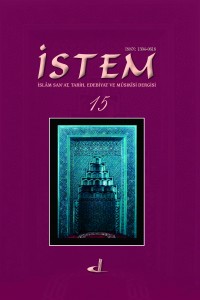Abstract
Victoria Rowe Holbrook bu çalışmasında onsekizinci asrın sonralarında yaşayan Osmanlı şâiri Şeyh Gâlib’in Hüsnü Aşk’ı ile onüçüncü asırda Anadolu’da yaşayan Mevlânâ Celâleddin-i Rûmî’nin Mesnevî isimli eserini karşılaştırmıştır. Gâlib’in Hüsn ü Aşk’ı Mevlânâ’nın Mesnevî’sine göndermeleri içerir. İki eser arasındaki karşılaştırma her iki şâirin eserinde de yer alan ortak bir hikaye ve bu hikayede yer alan Sûretler Kalesi mecazı üzerinden yapılmıştır. Victoria Rowe Holbrook metinlerarasılığı kullanarak Gâlib’in Mevlânâ’dan tevârüs ettiği, hatta bu iki şâirin kadim gelenekten birlikte tevârüs ettikleri temsiller üzerinde durur ve bu iki şâirin referanslarındaki ortaklığa atıfta bulunur.
Abstract
In this study, Victoria Rowe Holbrook compares Hüsn ü Aşk, written by the Ottoman poet Galib, who lived in the late 18th century, with Mathnavi of Mevlana Celâleddin-i Rûmî, who lived in the 13th century in Anatolia. Galib’s Hüsn ü Aşk contains many references to Mathnavi of Rumi. The comparison of the two works is established upon the same story and the shared metaphor called “the fortress of forms” which is mentioned in both Hüsn ü Aşk and Mathnavi. Victoria Rowe Holbrook, using intertexyuality, refers to the elements which Gâlib inherited from Rûmî and the elements both poets inherited from the ancient tradition. She also points to parallel sources of these two poets
Details
| Other ID | JA64BB74GU |
|---|---|
| Journal Section | Articles |
| Authors | |
| Publication Date | December 1, 2010 |
| Submission Date | December 1, 2010 |
| Published in Issue | Year 2010 Issue: 15 |
This work is licensed under a Creative Commons Attribution-NonCommercial 4.0 International License (CC BY NC).

